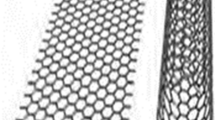Abstract
The controlled growth promoted by the use of ligands can affect the structural properties of nanoparticles, preferential growth and most likely exposed facets in their final shape. The chemistry is deeply dominated by the close relationship between both the interaction of the ligands and the metal structure. In the present work, we have illustrated the change in the nanoparticle shape as a function of a series of nitrogen bases. Particularly, we have employed Density Functional Theory to obtain the interaction energies of a series of nitrogen containing bases to gold surfaces with different orientations. The adsorption strength is found to correlate with the HOMO position of the ligand thus providing a fast screening tool for this property. Moreover, for small N-bases with high N content we have found that the shape can be tuned as a function of the coverage and the final structure at high coverages severely departs from that of bare gold nanoparticles. We have found variations in the different extension of the facets that can be further employed in obtaining structure sensitivity and the right chemical and catalytic performance.






Similar content being viewed by others
References
Daniel M-C, Astruc D (2004) Gold nanoparticles: assembly, supramolecular chemistry, quantum-size-related properties, and applications toward biology, catalysis, and nanotechnology. Chem Rev 104(1):293–346
Hvolbæk B et al (2007) Catalytic activity of Au nanoparticles. Nano Today 2(4):14–18
Falsig H et al (2008) Trends in the catalytic CO oxidation activity of nanoparticles. Angew Chem Int Ed 47(26):4835–4839
Barmparis GD, Remediakis IN (2012) Dependence on CO adsorption of the shapes of multifaceted gold nanoparticles: a density functional theory. Phys Rev B 86(8):085457
Siler CGF et al (2014) Switching selectivity in Oxidation reactions on gold: the mechanism of C–C vs C–H bond activation in the acetate intermediate on Au(111). ACS Catal 4(9):3281–3288
Cremer T et al (2014) Tuning the stability of surface intermediates using adsorbed oxygen: acetate on Au(111). J Phys Chem Lett 5(7):1126–1130
Kosuda KM et al (2012) Oxygen-mediated coupling of alcohols over nanoporous gold catalysts at ambient pressures. Angew Chem Int Ed 51(7):1698–1701
Stowers KJ, Madix RJ, Friend CM (2013) From model studies on Au(111) to working conditions with unsupported nanoporous gold catalysts: oxygen-assisted coupling reactions. J Catal 308(Supplement C): 131–141
Stephen A, Hashmi K (2004) Homogeneous catalysis by gold. Gold Bull 37(1):51–65
Heinz H et al (2017) Nanoparticle decoration with surfactants: molecular interactions, assembly, and applications. Surf Sci Rep 72(1):1–58
Barmparis GD, Honkala K, Remediakis IN (2013) Thiolate adsorption on Au(hkl) and equilibrium shape of large thiolate-covered gold nanoparticles. J Chem Phys 138(6):064702
Barmparis GD et al (2015) Nanoparticle shapes by using Wulff constructions and first-principles calculations. Beilstein J Nanotechnol 6:361–368
Almora-Barrios N et al (2014) Theoretical description of the role of halides, silver, and surfactants on the structure of gold nanorods. Nano Lett 14(2):871–875
Gómez-Graña S et al (2013) Au@Ag nanoparticles: halides stabilize {100} facets. J Phys Chem Lett 4(13):2209–2216
Li Q et al (2017) Shape control in concave metal nanoparticles by etching. Nanoscale 9(35):13089–13094
Chen G et al (2016) Interfacial electronic effects control the reaction selectivity of platinum catalysts. Nat Mater 15(5):564–569
Almora-Barrios N et al (2017) Concerted chemoselective hydrogenation of acrolein on secondary phosphine oxide decorated gold nanoparticles. ACS Catal 7(6):3949–3954
Fiorio JL, López N, Rossi LM (2017) Gold–ligand-catalyzed selective hydrogenation of alkynes into cis-alkenes via H2 heterolytic activation by frustrated Lewis Pairs. ACS Catal 7(4):2973–2980
Arndt S, Rudolph M, Hashmi ASK (2017) Gold-based frustrated Lewis acid/base pairs (FLPs). Gold Bull 50(3):267–282
Kresse G, Furthmüller J (1996) Efficient iterative schemes for ab initio total-energy calculations using a plane-wave basis set. Phys Rev B 54(16):11169–11186
Kresse G, Furthmüller J (1996) Efficiency of ab-initio total energy calculations for metals and semiconductors using a plane-wave basis set. Comput Mater Sci 6(1):15–50
Perdew JP, Burke K, Ernzerhof M (1996) Generalized gradient approximation made simple. Phys Rev Lett 77(18):3865–3868
Kresse G, Joubert D (1999) From ultrasoft pseudopotentials to the projector augmented-wave method. Phys Rev B 59:1758
Grimme S (2006) Semiempirical GGA-type density functional constructed with a long-range dispersion correction. J Comput Chem 27(15):1787–1799
Bučko T et al (2010) Improved description of the structure of molecular and layered crystals: ab initio DFT calculations with van der Waals corrections. J Phys Chem A 114(43):11814–11824
Almora-Barrios N et al (2014) Costless derivation of dispersion coefficients for metal surfaces. J Chem Theory Comput 10(11):5002–5009
Álvarez-Moreno M et al (2015) Managing the computational chemistry big data problem: the ioChem-BD platform. J Chem Inf Model 55(1):95–103
Singh-Miller NE, Marzari N (2009) Surface energies, work functions, and surface relaxations of low-index metallic surfaces from first principles. Phys Rev B 80(23):235407
Garcia-Ratés M, López N (2016) Multigrid-based methodology for implicit solvation models in periodic DFT. J Chem Theory Comput 12(3):1331–1341
Wulff G (1901) Zeitschrift fur Krishtallographie 34:449–530
Appl J (2011) VESTA 3 for three-dimensional visualization of crystal, volumetric and morphology data. J Appl Crystallogr 44:1272–1276
Shi H, Stampfl C (2008) Shape and surface structure of gold nanoparticles under oxidizing conditions. Phys Rev B 77(9):094127
Acknowledgements
This work was funded by the MINECO (Grant Number CTQ2015-68770-R) and Marie Curie-COFUND (Grant Number 291787-ICIQ-IPMP, M.S.). M. Domingo thanks Fundació la Caixa for a Summer Fellowship at ICIQ. We would like to thank BSC-RES for generous computational resources.
Author information
Authors and Affiliations
Corresponding author
Rights and permissions
About this article
Cite this article
Domingo, M., Shahrokhi, M., Remediakis, I.N. et al. Shape Control in Gold Nanoparticles by N-Containing Ligands: Insights from Density Functional Theory and Wulff Constructions. Top Catal 61, 412–418 (2018). https://doi.org/10.1007/s11244-017-0880-3
Published:
Issue Date:
DOI: https://doi.org/10.1007/s11244-017-0880-3




